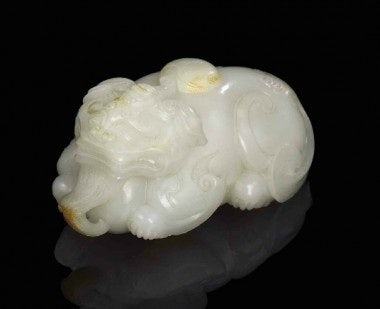Sotheby's Leads The Way, With Christie's Showing Strong Results As Well#

This jade carving sold for $2.1 million in New York, well over its high estimate of $180,000
Over this past weekend, both Sotheby's and Christie's saw strong results at a sprawling set of auctions in New York, as a relatively new set of buyers in the city -- mainland Chinese dealers and collectors -- crushed estimates to get their hands on important jade carvings, antique furniture, and bronze artifacts.
Continuing to show their preference for anything and everything related to the early Qing Dynasty and Qing emperor Qianlong (1711-1799), at Sotheby's Chinese Works of Art auction, Chinese collectors were instrumental in the sale of 225 of the 335 works on offer (67 percent), pushing the auction to a very impressive US$22.7 million total. As Art Market Monitor pointed out in the wake of the sale, estimates were completely disregarded by the primarily trade-related buyers, who pushed a Qianlong-era jade washer to US$782,500 (well over its high estimate of $350,000), a rare "huanghuali" recessed-leg long table to $722,500 (over its high estimate of $120,000), and a set of early Qing huanghuali armchairs to $506,500 (above a high estimate of $180,000). Clearly, the appetite of Chinese collectors for top-quality lots from popular historical periods knows no geographic boundaries.
Christie's, too, benefited this last weekend from this appetite, pulling in a whopping US$60.6 million across three sales, also in New York. 29 lots sold in the six figures (including buyer's premium) at the "Property from the Xu Hanqing Collection" auction, at which Chinese buyers paid special attention to jade carvings, traditional ink-and-wash paintings, and scholar's objects. As with the Sotheby's auction, estimates were completely ignored for particularly coveted lots, such as an unusual pale yellow jade figure of "a mythical beast" from the 17th century or earlier, which sold for US$722,500 --
nine times its high estimate#
of $80,000. Similarly eye-popping results were recorded at the "Superb Jade Carvings from an Important European Collector" auction, where a large pale green jade water pot and cover, expected to go for $90,000, sold for $2.7 million,
nearly 30 times its high estimate#
. Also crushing estimates was an incredibly rare white and russet jade animal-form water pot that sold for $2.1 million,
nearly 12 times its high estimate#
of $180,000.

This yellow jade carving of a mythical beast sold at the Xu Hanqing auction for $722,500, over a high estimate of $80,000
At the two-day Christie's "Fine Chinese Ceramics and Works of Art, Part One" auction, the popularity of zitan wood furniture and imperial artifacts was apparent in the sale of two small carved zitan stools from the 18th/19th century, which sold for US$482,500, well above their high estimate of $90,000. Likely a draw for the buyer was the clear provenance of the stools, acquired in Guangdong in the 1930s or '40s by the father of the present owner. Clear, easily verifiable provenance is a key selling point for mainland Chinese collectors in particular, who often prefer to purchase Chinese antiques in New York or London when possible, even over Hong Kong. Perhaps even more dramatic, though, was the sale of a rhinoceros horn archaistic cup from the 17th/18th century, which sold for $386,500, or nearly 10 times its high estimate of $40,000, and a late Shang Dynasty (12th/11th century BCE) bronze ritual tripod wine vessel, which sold for $902,500,
over 15 times its high estimate#
of $60,000. Coming from a private Japanese collection, this vessel had been owned by the same family for 90 years.
Though these auctions were held in New York, they reflect the buying habits of Chinese collectors and dealers in particular, and the strength of the bidding bodes well for the upcoming autumn auctions set to be held by Sotheby's and Christie's in Hong Kong. These two auction houses show that they continue to be able to procure artwork and artifacts of clearer provenance and overall better quality than their counterparts in mainland China, China Guardian and Beijing Poly, and they're leveraging this fact to dominate in Hong Kong. Though mainland Chinese auction houses are said to be eying global expansion and are pushing harder to develop their reputation in Hong Kong, this fall and beyond, expect Christie's and Sotheby's to put continued priority on early Qing jades, unusual (we must stress unusual) zitan furniture, and of course anything connected, even tangentially, to emperor Qianlong in order to stay strong in the former British colony.
On the more contemporary side, though, keep an eye out for Jing Daily's "Top Lots to Watch" at Sotheby's much-anticipated Contemporary Asian Art auction in Hong Kong on October 3, coming later this week.